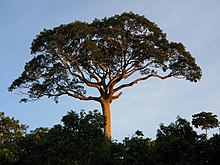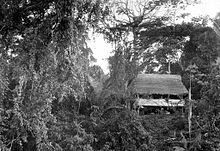Panguana

9°36′49″S 74°56′08″W / 9.6137°S 74.9356°W
Panguana is a biological research station, founded in 1968 and since 2011 it is also a private conservation area extending over almost 10 km2 of tropical primary forest in Peru.[1]
Geography and Biodiversity
Panguana is located in the low land
The research area's terrain is slightly hilly and contains various water bodies, non-flooded terra firme, swamp, alluvial and secondary forests, and also some plantations and pastures in the western border areas.
In the east, the area borders the territory of the indigenous people of the Asháninka. Their area stretches to the Sira mountains, which are about 40 km away and almost 2500 m high. It is only extensively used and largely covered by primary rainforest. About 4 km east of the station is a central village of the people with a school, where the Asháninka children from the area go to. Panguana supports this school to teach the local people the value of their rainforest.
The annual average temperature is 24.5 °C, but temperatures of over 40 °C or more are quite frequent during the
Large parts of the Panguana conservation area are still covered by primary Amazon rainforest, and thus show a very high
Research station

The aim of the research station Panguana is to explore the biodiversity of flora and fauna, and study their ecological relationships. In addition, a unique ecosystem is protected and preserved.
Through continuous scientific work, the diverse flora and fauna can be explored, systematically assigned and the different ways of life and biological relationships documented. Numerous diploma and doctoral studies were made in Panguana and many international expeditions were held there. To date, more than 180 scientific
For better observation, over 20 km of paths were cut into the jungle. The station has three guest houses with a laboratory for about 14 people, a round house for dining and workshops, several boats and a
History

The biological research station Panguana was founded in 1968 by the biologists
In the 1970s, Hans-Wilhelm Koepcke's unsuccessfully tried to promote Panguana as a nature conservation area[2] and in 1972 the area became an official scientific research area (zona de estudio científico del Ministerio de Agricultura, Direccíon forestal, de caza y Tierras).[7] Finally at the end of 2011, the newly created Peruvian Ministry of Environment declared Panguana as a private conservation area (Area de Conservación Privada) in order to protect the area permanently from clearing, hunting and colonization.[1][8]
Literature
- Juliane Koepcke und Beate Rygiert: Als ich vom Himmel fiel. Malik, München 2011, ISBN 978-3-8902-9389-9.
References
- ^ a b c d e f g h i j k Panguana web page. Retrieved on 20 July 2017
- ^ a b c d Gunnar Henze - "Paradies Panguana" Archived 2015-09-23 at the Wayback Machine. Bild der Wissenschaft 08/2011. Retrieved on 20 July 2017
- ^ a b c d J. Römbke, M. Verhaagh: About earthworm communities in a rain forest and an adjacent pasture in Peru. Amazoniana 1992, 12:29-49, cited after Rainer Hutterer, Manfred Verhaagh, Juliane Diller, Richard Podloucky: An inventory of mammals observed at Panguana biological station, Amazonian Peru Ecotropica 1995/1
- ^ ISBN 3-925631-05-4
- ISBN 978-3-8902-9389-9, S. 287
- ^ Juliane Diller, Ernst-Gerhard Burmeister, Panguana – ein peruanischer Vogelname für eine bayerische Urwaldforschungsstation, aviso 2007-01, S. 46–49
- ^ Rainer Hutterer, Manfred Verhaagh, Juliane Diller, Richard Podloucky: An inventory of mammals observed at Panguana biological station, Amazonian Peru Ecotropica 1995/1
- ^ RESOLUCIÓN MINISTERIAL N° 300-2011-MINAM (PDF; 2,3 MB)
